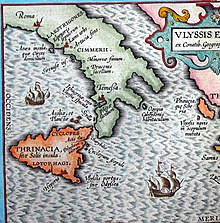Aeaea

Aeaea, ÆæaorEëä(/iːˈiːə/ee-EE-əor/əˈiːə/ə-EE-ə;Ancient Greek:Αἰαία,romanized:Aiaíā[ai̯.ǎi̯.aː]) was amythologicalisland said to be the home of the goddess-sorceressCirce.
"Circe would fain have held me back in her halls, the guileful lady of Aeaea, yearning that I should be her husband". (Homer,Odyssey, Book IX.32;trans. A.T. Murray; Loeb Classical Library 1919).
InHomer'sOdyssey,OdysseustellsAlcinousthat he stayed here for one year on his way home toIthaca.Before leaving Aeaea, Odysseus was given instructions by Circe about how to cross the ocean[1]and assisted by theNorth Windto reach theunderworld:
When your ship has traversed the stream ofOceanus,you will reach the fertile shore of Persephone's country with its groves of tall poplars and willows that shed their fruit untimely; here beach your ship upon the shore of Oceanus, and go straight on to the dark abode of Hades.
Description
[edit]Homer describes Aeaea as covered with a mixture of pasture and dense woodland of oak and beech. There were high hills or bluffs from which the sea could be seen encircling the island in all directions. Circe's stone house was located in a "dense forest of trees" "in a place that could be seen from far."[2]
Location
[edit]
The somewhat inconsistentgeography of Homer'sOdysseyis often considered more mythic than literal, but the geography of the Alexandrian scholar and poetApollonius of Rhodesis more specific. In his epicArgonautica,he locates the island somewhere south ofAethalia(Elba), within view of theTyrrhenianshore (western coast ofItaly).[3]( 4.654–661)In the same poem, Aeëtes remarks on the great distance betweenColchis(on theBlack Sea,in modernGeorgia) and Aeaea in these terms:
I noted it once after taking a ride in my fatherHelius' chariot when he was taking my sister Circe to the western land and we came to the coast of theTyrrhenian mainland,where she dwells to this day, very far from the Colchian land
Aeaea was later identified by classical Roman writers withMount CirceoonCape Circeo(Cape Circaeum) on the western coast ofItaly– about 100 kilometers south ofRome– which at that time may have looked like an island owing to the marshes and sea surrounding its base, but which now is a smallpeninsula.Dionysius of Halicarnassuswrote that it was already a peninsula in his time. However, it may have been still an island in the days ofHomer,with a long "lido"or sandy peninsula that gradually became attached to the mainland – a common geological process. Archeologists have identified one cave or grotto on the cape asGrotta della Maga Circe( "cave of Circe" ). A second cave was found on the nearby Island ofPonza.It is believed that Circe had her summer home on Mount Circe and her winter home onPonza,which possibly was the island Homer calledAeaea.
The modern Greek scholarIoannis Kakridisinsists that any attempt at realistic identification is in vain, arguing that Homer vaguely located Aeaea somewhere in the eastern part of his world, perhaps nearColchis,since Circe was the sister ofAeëtes,king of Colchis, and because their paternal aunt the goddessEoshad her palace there. Cooper (1854, p. 266), in his edition of the Works of Virgil,[4](III.386)comments onAeneis:"She [Circe] is here calledAeaean,from Aea, an island and city of Colchis, not far from the river Phasis. She married a king of Sarmatia, whom she poisoned, after which she fled into Italy... "[4]
Other Hypothetical Locations from Literature
[edit]Robert Graves(The Greek Myths) points out Aeaea as the island ofLošinj,near theIstrian peninsulain the northAdriatic Sea.
Fernando Jaume identifies the “Island of Circe” withDidymeakaSalina,the “erratic rocks” being the “Faraglioni di Lipari”, next to the “Island of the Sirens” and the “Hades in Sicily”, perhaps as many evocations of the volcanism of this archipelago. The narrow beach and the forests dedicated toPersephonewould be there, inAcquedolci,and Sicily is the home of Circe's fatherHelios's sacred herds of oxen and sheep.
Tim Severinnames inThe Ulysses Voyagethe island ofPaxosnear the Greek coast of theIonian Sea.He describes it as the furthest west on a boundary of the sea and the river of Okeanos, the mythological freshwater river that encircles the Earth. Drawing upon this interpretation,Assassin's Creed Odysseyuses a fictional atoll point off the coast of Paxos as the location.
Aeaea in literature
[edit]InRichard Aldington's novelAll Men are Enemies(1933), Aeaea is the island, "twelve hours fromNaples"(obviously mythical), where his heroes meet, and love between them flourishes.[5]
John Banville's 1993 novelGhostshas a boating party shipwrecked on an unnamed island; one character, Sophie, speculates that it is Aeaea; another says, "Yes...yes, Aeaea: you will feel at home, no doubt", a reference to Sophie's Circean nature.[6]
"Aeaean" was an epithet ofCirceand her paternal nieceMedea(Αἰαίη), who were the sister and daughter ofAeëtes,the ruler of Aea (Αἶα) inColchis.[7][8][9]Circe's sonTelegonusis likewise given this epithet.[10]It was also a name ofCalypso,who was believed to have inhabited a small island of the name of Aeaea in the straits between Italy and Sicily.[11][12]
References
[edit]- ^Homer.Odyssey.10.503– viaTufts U.(perseus.tufts.edu).
- ^ab"Book X. Æolus, the LÆstrygones, Circe".Odyssey.RetrievedOct 4,2022– viaWikisource.
- ^abApollonius Rhodius(2008).Argonautica.Loeb Classical Library.Translated by Race, William H. Harvard U. Press.
- ^abPublii Virgilii Maronis(1854). Cooper, J.G. (ed.).Opera: The works of Virgil(9th ed.). New York, NY. p. 266.
{{cite book}}:CS1 maint: location missing publisher (link) - ^"Books: Softer Answers".Time.1933-07-31. Archived fromthe originalon May 28, 2010.Retrieved2010-04-23.
- ^Banville, John.Ghosts,page 7.
- ^Apollonius of Rhodes,iii. 1136, iv. 559
- ^Homer,Odysseyix. 32
- ^Virgil,Aeneidiii. 386
- ^quid petis Aeaei moenia Telegoni?,Propertius2.32.4
- ^Pomp. Mela, ii. 7
- ^Propert. iii. 10. "81
Sources
[edit] This article incorporates text from a publication now in thepublic domain:Smith, William,ed. (1870). "Aeaea".Dictionary of Greek and Roman Biography and Mythology.
This article incorporates text from a publication now in thepublic domain:Smith, William,ed. (1870). "Aeaea".Dictionary of Greek and Roman Biography and Mythology.
